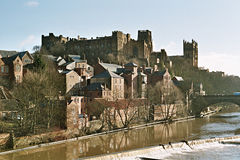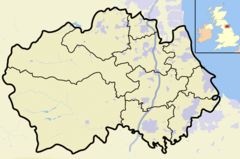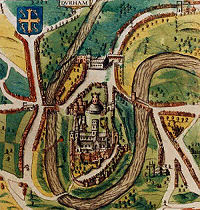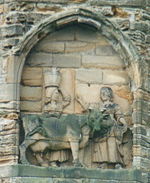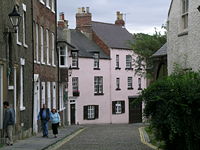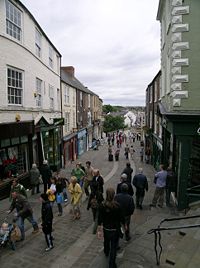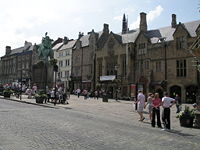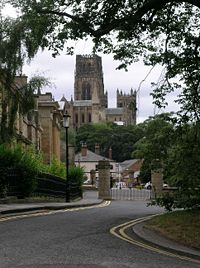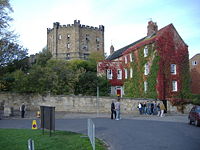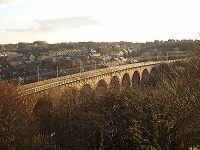Durham
2008/9 Schools Wikipedia Selection. Related subjects: British Cities; Great Britain
| Durham | |
|
Durham shown within County Durham |
|
| Population | 42,939 ( 2001 Census) |
|---|---|
| OS grid reference | |
| District | City of Durham |
| Shire county | County Durham |
| Region | North East |
| Constituent country | England |
| Sovereign state | United Kingdom |
| Post town | DURHAM |
| Postcode district | DH1 |
| Dialling code | 0191 |
| Police | Durham |
| Fire | County Durham and Darlington |
| Ambulance | North East |
| European Parliament | North East England |
| UK Parliament | City of Durham |
| List of places: UK • England • County Durham | |
Coordinates:
Durham (pronounced /ˈdʌrəm/ in RP, locally IPA: [ˈdʏrəm]) is a small city and main settlement of the City of Durham district of County Durham, England.
It is well-known for its Norman Cathedral and Castle, and is home to Durham University. HM Prison Durham is also located close to the city centre.
History
Toponymy
The name "Durham" comes from Old English "dun-holm", meaning "hill-island". It was given this name due to its steep, hilly embankments.
Early history
Archeological evidence suggests a history of settlement at Durham since roughly 2000 BC. The present city can clearly be traced back to 995 AD, when a group of monks from Lindisfarne chose the strategic high peninsula as a place to settle with the body of Saint Cuthbert, that had previously lain in Chester-le-Street, founding a church there. (Legend says that the monks were led to the location by a milk maid who had lost her dun cow, which was found resting on this spot.) The present Durham Cathedral was built from 1093, and still contains the remains of St Cuthbert as well as The Venerable Bede. It is regarded by many - such as travel writer Bill Bryson -- as the finest cathedral in the world .
Facing the cathedral across Palace Green is Durham Castle, originally built by the Normans from 1071, on William the Conqueror's return from campaigning in Scotland. Some of the present structure is more recent, notably Anthony Salvin's Victorian restorations. The two buildings are jointly designated a UNESCO World Heritage Site- one of the original seven in the United Kingdom. Since 1837 the castle has been home to University College, the first college of the University.
In the three centuries following the construction of the Castle, Durham was regularly besieged by the Scots, with the notable Battle of Neville's Cross (1346) occurring just one mile west of the city.
In medieval times Durham was a major centre of both political and ecclesiastical power, mainly due to its strategic importance near the border with Scotland. County Durham was a palatinate, ruled by Prince-Bishops who had secular authority and considerable autonomy from Westminster, minting their own coinage, dispensing their own justice and with the right to maintain their own armies. Every Bishop of Durham from 1071 to 1836 was a Prince Bishop except for the first Norman-appointed bishop Walcher, who was an Earl-Bishop. (The term Prince Bishop, while a useful one, is not one which the Durham Bishops themselves would have recognised.) Henry VIII curtailed some of the Prince-Bishop's powers, and smashed the shrine of Cuthbert in 1538.
19th century onwards
Finally, the public climate surrounding the Great Reform Act of 1832 removed the Bishop's extraordinary powers.
In 1832 the University of Durham was founded, which has several buildings on the peninsula and on Elvet Hill on the other side of the river. The 19th century also saw Durham grow as a centre of the coal mining industry. The first Durham Miners' Gala was held in 1871, and remains a popular annual event.
Governance
The municipal borough was formerly known as 'Durham and Framwelgate', until it was merged with Durham Rural District and Brandon and Byshottles urban district to form the City of Durham district. Durham's MP is Roberta Blackman-Woods (Labour).
Geography
Durham is situated 13 miles (21 km) to the south west of Sunderland, England. The River Wear flows north through the city, making an incised meander which encloses the centre on three sides to create Durham's "peninsula". Durham is a hilly city, claiming to be built upon the symbolic seven hills. Upon the most central and prominent position high above the Wear, the cathedral dominates the skyline. The steep riverbanks are densely wooded, adding to the picturesque beauty of the city. West of the city centre, another river, the River Browney, drains south to join the Wear to the south of the city.
Durham won the Large Town award in the Britain in Bloom awards of 2005.
The county town of County Durham, Durham is located in the City of Durham local government district, which extends beyond the city, and has a total population of 87,656, and covers 186.68 square kilometres. The unparished area of Durham had a population of 29,091, whilst the built-up area of Durham had a population of 42,939.
Areas of Durham
The centre of Durham sits on a peninsula created by the River Wear. At the base of the peninsula is the market square, which still hosts regular markets; a permanent indoor market is also situated on the square. The square and surrounding streets are one of the main commercial and shopping areas of the city. From the market square, The Bailey leads south past Palace Green: The Bailey is almost entirely owned and occupied by the University and Cathedral.
There are three old roads out of the central Market Square. Saddler Street heads South-Easterly out of the square, towards Elvet Bridge, The Bailey and Prebends Bridge. Elvet Bridge leads to the Elvet area of the city, Durham Prison and the South; Prebends Bridge is smaller and provides access from The Bailey to South Durham. Heading west, Silver Street leads out of the Market Square towards Framwellgate Bridge and North Road, the other main shopping area of the city. From here, the city spreads out into the Framwelgate, Crossgate, Neville's Crossand viaduct districts, the other main shopping area of the city. Beyond the viaduct lie the outlying districts of Framwellgate Moor and Neville's Cross. Heading north from the market place leads to Claypath. The road curves back round to the east and beyond it lie Gilesgate, Gilesgate Moor and Dragonville.
Many of the inner city areas are now inhabited by students living in shared houses. In some roads as many as 70% of the dwellings are occupied by students.
Climate
Like the rest of the United Kingdom, Durham has a temperate climate. At 643.3 millimetres (25 in) the average annual rainfall is lower than the national average of 1,125 millimetres (44 in). Equally there are only around 121.3 days where more than 1 millimetre (0.04 in) of rain falls compared with a national average of 154.4 days. The area sees on average 1374.6 hours of sunshine per year, compared with a national average of 1125.0 hours. There is an air frost on 52 days compared with a national average of 55.6 days. Average daily maximum and minimum temperatures are 12.5 °C (54.5 °F) and 5.2 °C (41.4 °F) compared with a national averages of 12.1 °C (53.8 °F) and 5.1 °C (41.2 °F) respectively.
The table below gives the average temperature and rainfall figures taken between 1971 and 2000 at the Met Office weather station in Durham:
|
||||||||||||||||||||||||||||||||||||||||||||||||||||||||||||||||||||||||||||||||||||||
Economy
This is a chart of trend of regional gross value added of County Durham at current basic prices published (pp.240-253) by Office for National Statistics with figures in millions of British Pounds Sterling.
| Year | Regional Gross Value Added | Agriculture | Industry | Services |
|---|---|---|---|---|
| 1995 | 4,063 | 47 | 1,755 | 2,261 |
| 2000 | 4,783 | 40 | 1,840 | 2,904 |
| 2003 | 5,314 | 39 | 1,978 | 3,297 |
Landmarks
The whole of the centre of Durham is designated a conservation area. The conservation area was first designated on 9 August 1968, and was extended on 25 November 1980. In addition to the Cathedral and Castle, Durham contains over 630 listed buildings, 569 of which are located within the city centre conservation area. Particularly notable properties include:
Grade I listed
- Chorister School
- Crook Hall
- Durham Castle
- Durham Cathedral
- Elvet Bridge
- Framwellgate Bridge
- Kepier Hospital
- Kingsgate Bridge
- Prebends Bridge
- St Giles Church, Gilesgate
- Church of St Margaret of Antioch, Crossgate
- Church of St Mary-le-Bow (now Durham Heritage Centre)
- Church of St Mary the Less
Grade II* listed
- Aykley Heads House (now Bistro 21)
- Bishop Cosin's Hall, Palace Green
- Cosin's Library (now part of University Library, Palace Green)
- Crown Court, Old Elvet
- St Cuthbert's Society, 12 South Bailey
- St John's College, 3 South Bailey
- St Oswald's Church
- Railway viaduct, North Road
- Town Hall and Guildhall, Market Place
Transport
Durham railway station is situated on the East Coast Main Line between Edinburgh and London; rail travellers coming from the south enter Durham over a spectacular Victorian viaduct high above the city. By road, the A1(M), the modern incarnation of the ancient Great North Road, passes just to the east of the city. (Its previous incarnation, now numbered A167, passes just to the west.) Newcastle Airport lies to the north, and Durham Tees Valley Airport to the south, both being about 25 miles away. The Market Place and peninsula form the UK's first (albeit small) congestion charging area, introduced in 2002.
A park and ride service is also available.
Sport
Durham is home to Durham CCC of the cricket County Championship which they joined as an expansion team in 1992. They play their homes matches at the Riverside Ground. The town's football club Durham City AFC once boasted a membership of the Football League between 1921 and 1928 but have long been a non-league club. The 2008/09 season will see them make a step up the pyramid to play in the Unibond League. Their home ground is New Ferens Park, known as The Arnott Stadium for sponsorship reasons.
Notable people
- Gem Archer, Guitarist with the band Oasis
- Rowan Atkinson, Actor (attended the Chorister School)
- Pat Barker, Novelist ('Regeneration' trilogy)
- Barnabe Barnes, Elizabethan poet
- Tony Blair, former Prime Minister of the United Kingdom (attended the Chorister School)
- Count Joseph Boruwlaski, Celebrated dwarf
- Edward Bradley, Novelist ('Cuthbert Bede')
- Richard Caddel, Poet
- George Camsell, International footballer
- Paul Collingwood, International cricketer (born in Shotley Bridge, but lives in Durham)
- Wendy Craig, Actress
- Sir Kingsley Dunham, Director British Geological Survey
- John Bacchus Dykes, Hymnologist
- John Meade Falkner, Arms manufacturer and novelist (Moonfleet)
- James Fenton, Journalist and poet (attended the Chorister School)
- Godric of Finchale, Hermit and popular medieval saint
- Andy Gomarsall, MBE International Rugby union player
- John Gully, Pugilist
- Ian Hay, Novelist
- Violet Hunt, Novelist and 'new woman'
- Cyril Edwin Mitchinson Joad, Philosopher and radio broadcaster
- Roy Keane, Manager of local Premier League Team Sunderland AFC
- Lawrence of Durham, Poet
- Sir John Grant McKenzie Laws, Lord Justice Laws, Judge (attended the Chorister School)
- William Pearson, Watercolorist, Topographer
- Anna Maria Porter, Novelist
- Jane Porter, Novelist
- Michael Ramsey, the 100th Archbishop of Canterbury, and once Bishop of Durham
- Reginald of Durham, Hagiographer
- Gordon Scurfield, Biologist and author
- Christopher Smart, Poet
- Joseph Spence, Literary memoirist
- Anne Stevenson, Poet
- Robert Surtees, Historian and antiquarian
- Symeon of Durham, Historian
- Hugh Walpole, Novelist
- Walter of Durham, 13th century painter
- Sir Arnold Wolfendale, Astronomer Royal
- Sir Peter Vardy, (attended the Chorister School)
- James Wood, Literary Critic
